Films were first shown in Elsternwick Theatre in 1911. The Classic Elsternwick mixes old and new to keep up the tradition. Also hosts the Jewish International Film Festival
My experience at the cinema
I actually liked my vintage experience at the Classic Cinema, Elsternwick. There’s a great mix of the modern and the old around this place, from the façade through the foyer and to the auditoriums themselves.
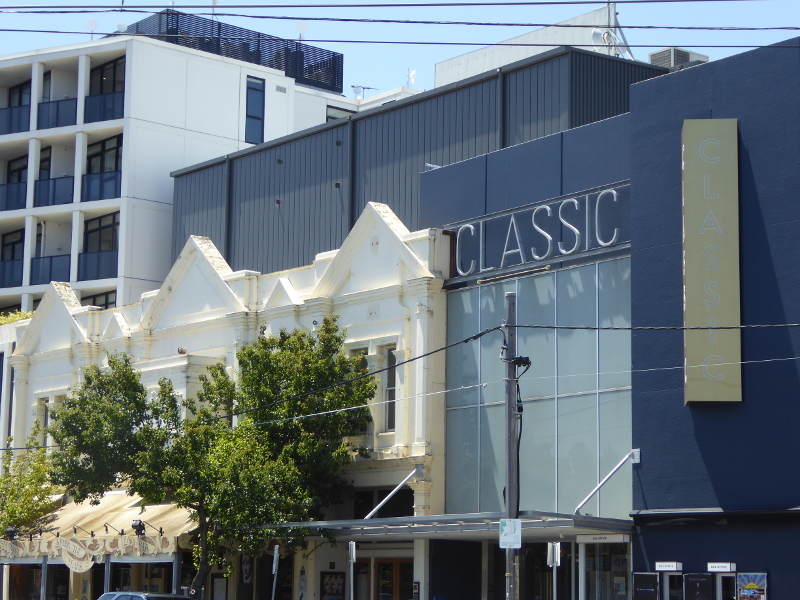
The original building from the 1890s was just a public hall, but films were first shown here in 1911.

Stand in front of the Classic today, and while the name is in modern typeface, you can still see the triple eave frontage from the first building, Elsternwick Hall.
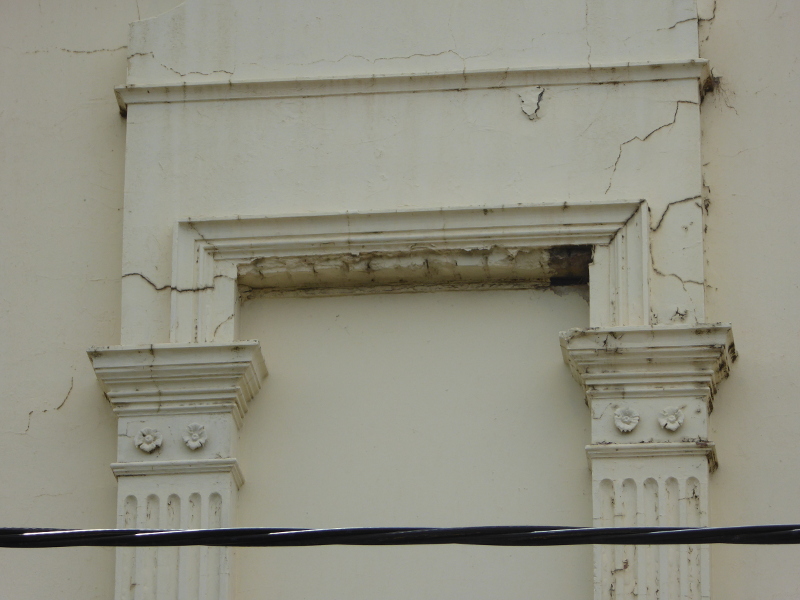
It’s a bit tatty in places, and a large part of the old façade is hidden behind a tall, leafy tree, but at least it’s still there.
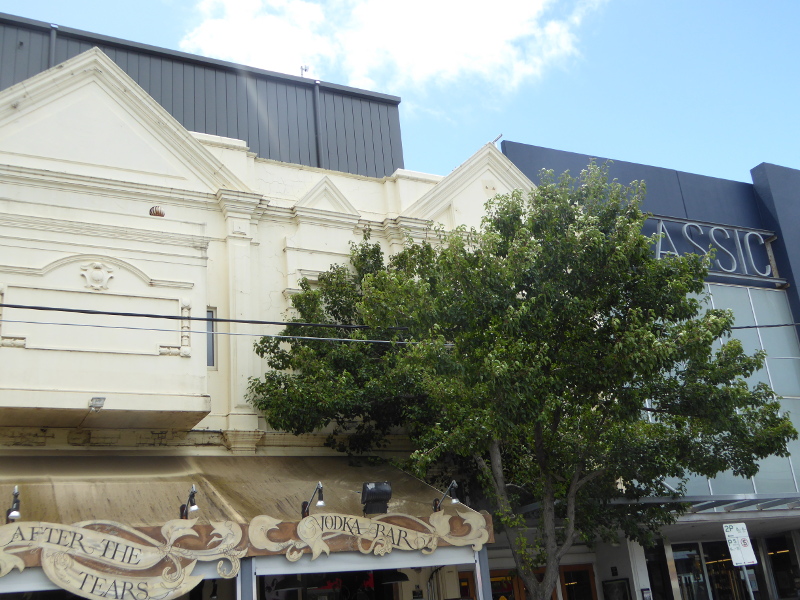
And I guess unlike one of those later art deco palaces built for showing films (Rivoli, Camberwell, or Astor, St Kilda), the Elsternwick Theatre as it was then called, wasn’t designed with films in mind.
I was there for a lunchtime Sunday screening of 1917, and had time to grab a coffee and sit in the foyer to have a look around before going in to my auditorium.
It’s actually a good spot to sit on the high stools at the long table by what was probably the original cinema entrance.
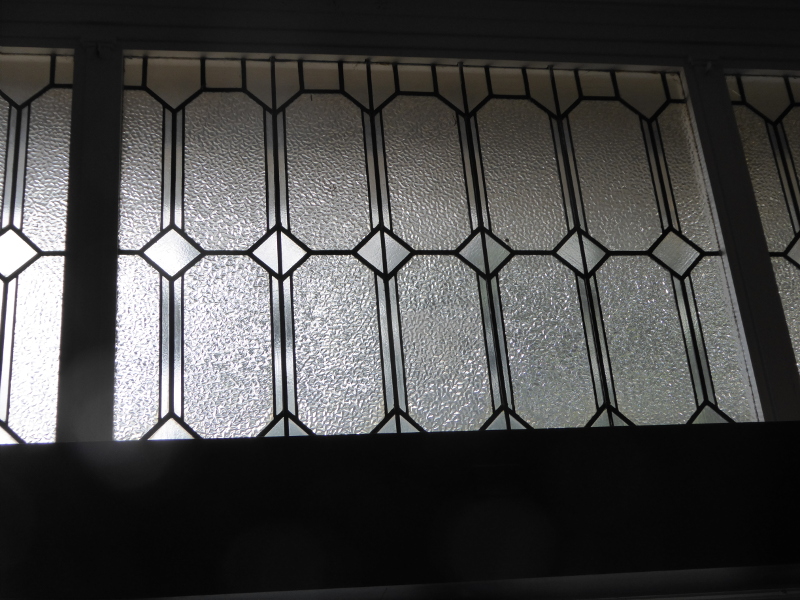
Next to me and up above were these lovely art deco windows.
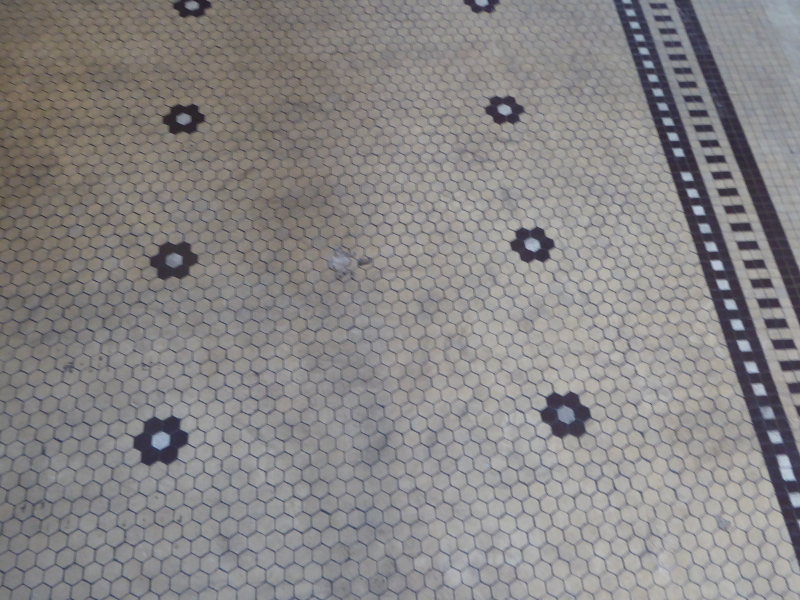
Below me, was this tiling, perhaps less flamboyant than some of the grander vintage cinemas I’ve been to lately, but I couldn’t help wondering if the tiling dated from after 1911 when this became a cinema proper – is that not a line of film reel depicted along the edge of the tiling?

Right in front of me was the entrance to what is now a restaurant, though it was once part of the theatre somehow. A separate business these days, I think, and restaurant-goers are asked to enter via the front, not this side door. But above the doorway is a line of tea pots (not sure why, but pretty), and some of the original wall mouldings, either from the very start of this building as a public hall, or the early cinema.
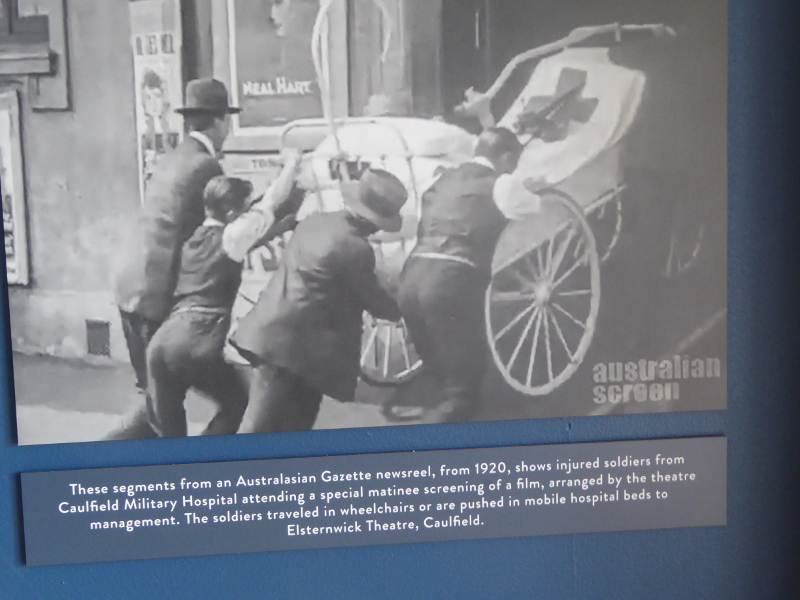
And then tucked behind a pillar are a couple of really interesting photos – I’d actually love to see more of these around the place, personally. They depict a scene from 1920 when the Elsternwick Theatre would hold film screenings for the war wounded, and they’d be wheeled in from nearby rehab units or hospitals.
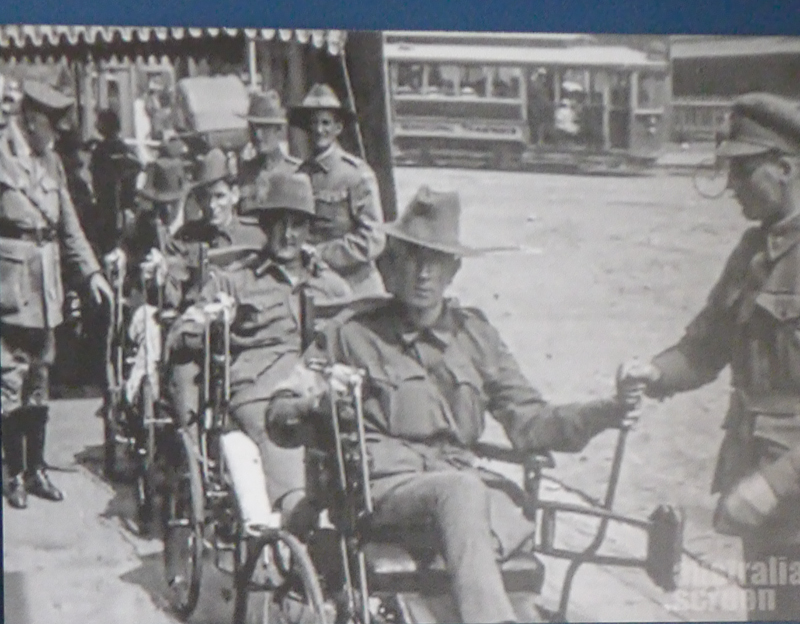
What a fantastic service to the community that must have been.

There is more history towards the back of the foyer, with a lovely old photo of a packed house of cinema-goers from some earlier era.
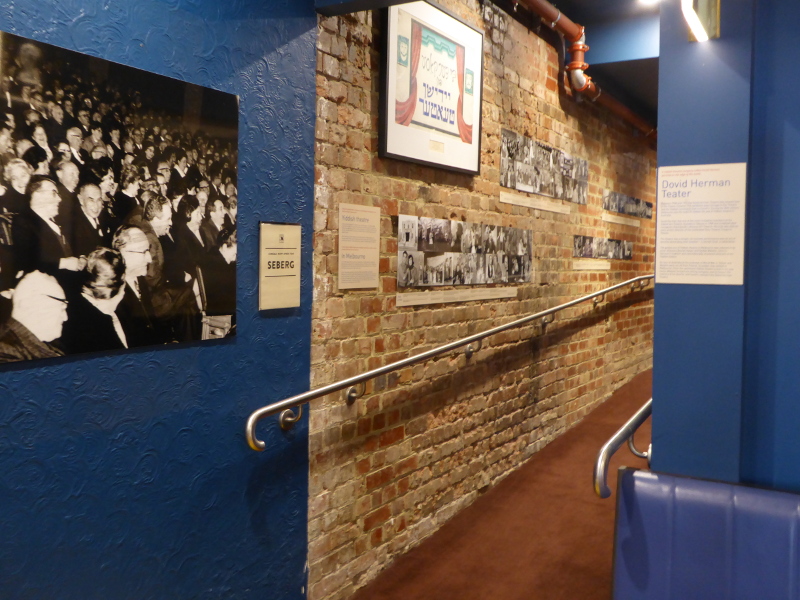
And beyond that there is a whole corridor of exhibits to commemorate the David Herman Theatre, showing how the venue has connected to the local Jewish community. I’d love to have gone inside the brick-walled theatre to see my film (there’s a great photo of it on the cinema history page), but 1917 was on in another room (Seberg was on here), so I had to make do with a quick look at some of the extraordinary film and theatre posters linking the Jewish community across the world, to places as far away as Cuba or Argentina.
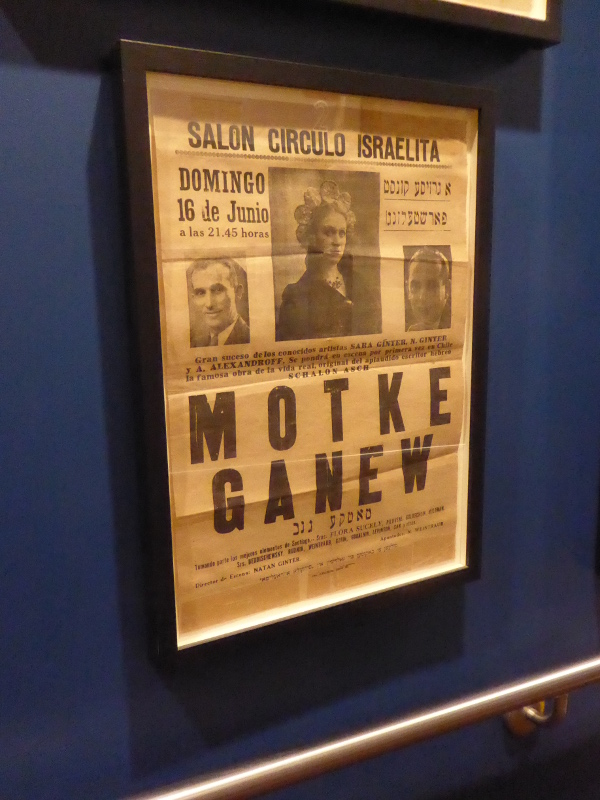
Apparently the Classic, Elsternwick plays host to the Jewish International Film Festival, and it clearly must have a fairly large Jewish component to its audience because the two private schools advertising before my film started were both Jewish colleges.
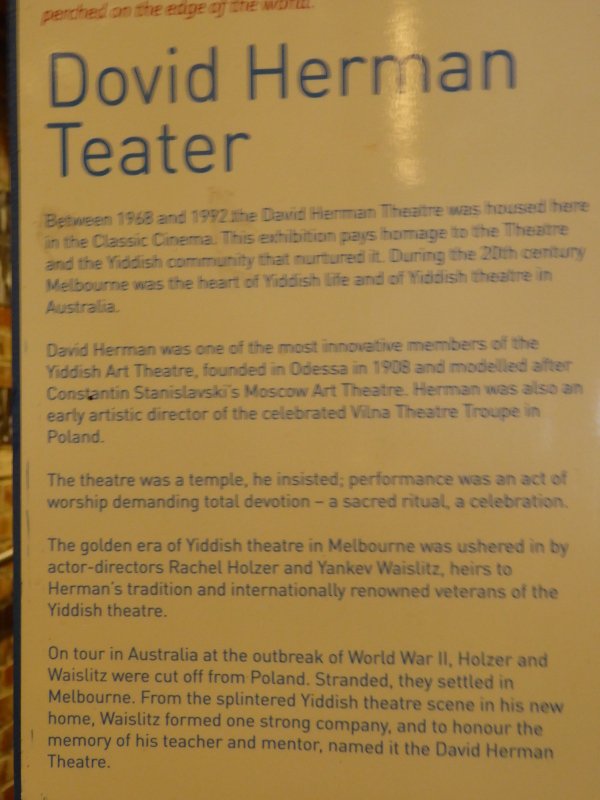
I would say 85% of the ads shown before the film I saw were for local businesses, which also says a lot about how much the Classic wants to connect to community.
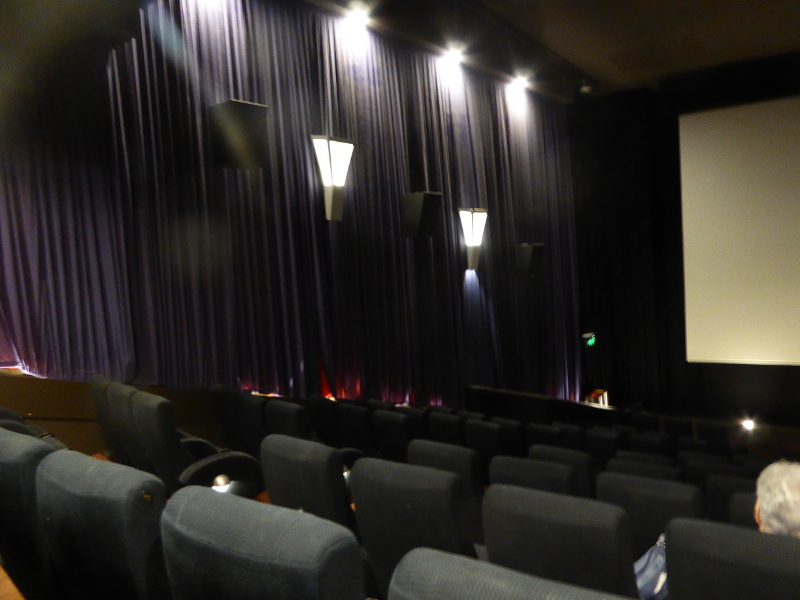
My auditorium was probably one of the newer cinema screens added in the latest renovation of the Classic, so not much vintage to be seen in here, though the wall lamps gave a vague nod to art deco (maybe).
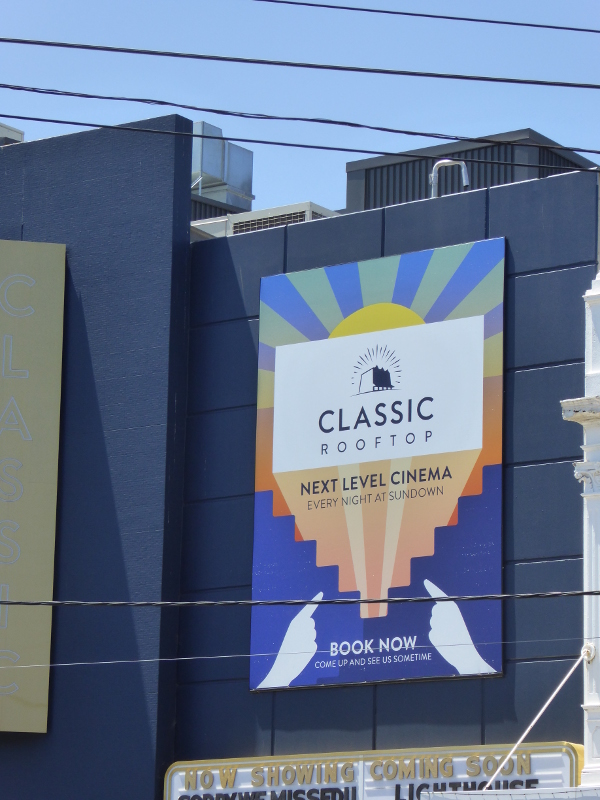
Overall, I really like the Classic. I wanted to see all the films they previewed ahead of 1917, and I think it’s always a healthy sign of a cinema’s atmosphere, when you end up chatting to other film-goers – complete strangers till then – about the film we just saw.
Practicalities
$22.50 to see a film on Sunday matinee
Coffee and cakes pretty good and lots of space to sit if you have time before the movie.
Directly across the road from Elsternwick train station on the Sandringham line
History and stories about the Classic Cinema and Elsternwick Theatre
First opened as a picture theatre in 1911 in what used to be the Elsternwick Hall. The local paper called it a ‘delightful resort for an evening’s entertainment.’ Almost 1,000 people attended the opening night in September of that year, and the Councillor who opened proceedings recalled the days (only eight years earlier) when Elsternwick’s only access to the ‘pictures’ was a bloke with a screen on the back of a wagon, which visited the district once a week.
I loved the enthusiasm in the news reviews of the films on show about a month later: “The aviator and the journalist’s wife’ had a ‘real aeroplane’ and ‘real flying with a passenger.’ Easy to forget what a novelty film was back then.
By November 1911, word had got around Elsternwick, and a Saturday night screening would be sold out, with late-comers turned away before the films began.
In the early days, the cinema manager obviously used to send a brief report each week for the local newspaper in which the films of the week would be advertised. The adjectives used to describe the theatre were usually ‘well-appointed’, and ‘comfortable’, though I was intrigued by how frequently the report spoke of good crowds attending the films ‘in spite of the hot nights’, suggesting it was none too cool inside the Theatre in those days…
The name Louise Lovely would have been a familiar, and very glamorous draw for audiences to the Elsternwick Theatre in 1925. She had had a career in silent movies in Hollywood and had returned to Australia to try (unsuccessfully, as it happened) to get into film production. But as a celebrity name in a fund-raiser for the Alfred Hospital, she would have been a great success for the Elsternwick.
I read somewhere that by 1929 the Theatre had become a dance hall. There were other cinemas in Elsternwick by then (Phoebe opened in 1916, the Renown in 1921) and dances would bring the crowds in. But an article about a robbery in 1930 still referred to the place as the Picture Theatre: slightly bizarre booty from the burglary, though: two electric fans, an electric urn and a suitcase – make of that what you will (communal tea parlour as Depression began to hit? Or selling on and getting away, with the suitcase?).
So through the 1930s and the war years, the building was basically a dance hall, called first the Astor and then the Dorchester. Dances were often fund-raisers (for bush-fire relief in 1939, the war effort from 1939 onward), but also for community groups and for weddings. ‘Bridge and dance’ evenings were an intriguing mix I noticed at times; and the ‘swing’ dance parties must have been fun, and really quite modern for the times.
In 1946, the building became a cinema again, this time called the Esquire. Trove failed to give me any stories on the Esquire, though; there were just two small ads from cinema-goers who lost a watch and a wallet in the theatre and were offering rewards for their return.
The Esquire became the Sharon Theatre in 1969, though tragedy hit within weeks as the cinema was badly damaged by fire. It finally opened as the Classic in 1971, but again Trove is short on news stories, except for a couple of pieces advertising specialist film festivals where the Classic was a venue (one Swiss Cinema, and one Jewish films in the 80s and 90s – see my link below on the cinema’s own website on the Jewish film connections).
If anybody has stories of their own from the Classic – or Esquire – days, do get in touch and help fill in the gaps here…Actually make sure you go to the links below where one story in particular from 1993 really impressed me, making a real-life connection between Schindlers List and an Elsternwick resident…
One final comment, though, on the history of the Classic: the danger with internet research is how easy it is to copy and paste ‘information’ you read on a website. Many pages claim the Classic is the ‘longest continuously operating cinema in Victoria’, but I don’t see how that can be, since some of those same pages acknowledge that it was closed from 1929-31, then a dance hall from 1931-46, and closed again after the 1969 fire until the Classic opened in 1971.
Maybe there is a good explanation for that ‘longest operating’ line, but I’d like to see it before I actually make a similar claim, having been to several other long-standing vintage cinemas in Victoria…
Other links and writings on the Classic
This article is about the current owners and their desire to keep a community cinema feel, but adding new screens and retaining old features.
This links to the Classic Cinema’s own website – its history page explains about the Sharon Theatre fire a month after opening; and explains how the cinema hosts the Jewish International Film Festival.
This article is fascinating on the Classic’s resident ghosts…
The Victorian Heritage Database has an entry on the Elsternwick Theatre.
The Classic was an entry in the Premier’s Design Awards for its internal refurbishment in 2018.
But the best story of all is surely that of Leo Rosner who was one of the Jews saved by Schindler, and he was present at the Classic on the night Schindlers List premiered in 1993. Scroll down to Page 4 of this newsletter for that story…
What are your memories of the Classic Cinema?
Have you been a regular at the Classic since it opened its doors in 1971? Or If anybody has stories of their own from the days when it was called the Esquire, do get in touch and help fill in the gaps in my story here.
Has anyone got memories of the cinema being as full as it was in that old photo on the cinema wall today? What film were you seeing then?
Or has anyone got any stories to fill in my usual gaps from the 1950s onwards?


I remember going to the Saturday Matinees during the late fifties. The cinema was then owned by a Mr Howard whose daughter Evelyn was a good friend of mine. We both lived in Kent Road Elwood in 1956. Evelyn went to MLC. Mr Howard (and I don’t remember his first name) was a very generous cineaste and canny businessperson.
Thanks Julia. Great to hear from someone who knew the cinema first hand in the 1950s
I first went to the Esquire Elsternwick in about 1957 to see LES GIRLS with my mother. I would have been about eight at the time. We lived in Caulfield.
I worked in the cinema business, mainly for Hoyts, as a projectionist. In the late sixties I worked a couple of matinees of THE SOUND OF MUSIC at the Renown theatre in Glen Huntly Road (which burned down in about 1970). My main job was as assistant projectionist at the Regent South Yarra (which also burned down a year or two later).
I did attend the Classic (or was it the Sharon?) many years later to see TAPS, and perhaps BLITHE SPIRIT, while Village was running the place. At that stage, the screen was at the back of the stage, as I believe that the owners of the building used the stage for Jewish social events on Sunday nights. I knew Bill Gaul, who was the projectionist there in the early seventies.
The walls of the auditorium were covered with gold curtains, a sixties fashion. The curtains reputedly came from the Hoyts Paris Cinema in Bourke St.
Much later on, in the 1990s, Russell O’Regan ran the cinema. I believe that Alan Simpson, who ran The Trak, was a partner in the business. He was also a partner at the Croydon Cinemas, where I worked in the 1990s.
Just after Eddie Tamir took over the Elsternwick cinemas, around 1996, I went there, looking for work. Unfortunately my sister fell ill at that time, and I suspended my employment search for a couple of months. I did get a good look at the projection room (the only one at that time) which was equipped with Toshiba gear, presumably during the Village days.
My only visit since then was to see STILL CRAZY, in the early noughties, in one of the new (then) cinemas.
I hope that this has been of some interest.
All the best — Eric White
Fantastic memories, Eric, Thanks for sharing them. I sometimes wonder if fire took away more cinemas than the coming of the Television…
The Clasic was owned by the Hayes family. I went to school with Wendy Hayes in Caulfield South and my uncle Wiil Gibbs
Shirlie Gillies (nee Therapos)
Lovely to read the comments and history. I remember the theatre as The Esquire and lived in Downshire Road during the early 40s and late 50s. It was a weekly treat to visit the cinema with my parents on Friday or Saturday nights – alternating with the Renown in Glenhuntly Road.